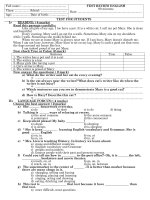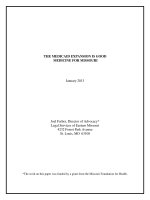Revise for exams good
Bạn đang xem bản rút gọn của tài liệu. Xem và tải ngay bản đầy đủ của tài liệu tại đây (289.23 KB, 12 trang )
Centre
Number
Candidate
Number
Surname
Other
Names
For Examiner’s Use
Notice to Candidate. The work you submit for assessment must be your own. If you copy from someone
else or allow another candidate to copy from you, or if you cheat in any other way, you may be disqualified.
Candidate Declaration. I have read and understood the Notice to Candidate and can confirm that
I have produced the attached work without assistance other than that which is acceptable under the scheme
of assessment.
Candidate
Signature
Date
Section
Mark
Section A
Task 1 Q1
General Certificate of Education
Advanced Subsidiary Examination
June 2013
Physics
(Specifications A and B)
Examiner’s Initials
PHA3/B3/X
Section A
Task 1 Q2
Section A
Task 2 Q1
Section B
Q1
Section B
Q2
Section B
Q3
TOTAL
Unit 3
Investigative and Practical Skills in AS Physics
Route X Externally Marked Practical Assignment (EMPA)
Section B
Written Test
For this paper you must have
l your completed Section A Task 2 question paper /
answer booklet.
l a ruler
l a pencil
l a calculator.
Instructions
l Use black ink or black ball-point pen.
l Fill in the boxes at the top of this page.
l Answer all questions.
l You must answer the questions in the space provided. Do not
write outside the box around each page or on blank pages.
l Show all your working.
l Do all rough work in this book. Cross through any work you do
not want to be marked.
Time allowed
l 1 hour 15 minutes
Information
l The marks for questions are shown in brackets.
l The maximum mark for this paper is 24.
Details of additional assistance (if any). Did the candidate receive any help or information in the production of this
work? If you answer yes, give the details below or on a separate page.
Yes
No
Practical Skills Verification
Teacher Declaration: I confirm that the candidate has met the
requirement of the practical skills verification (PSV) in accordance
with the instructions and criteria in section 3.8 of the specification.
Yes
Signature of teacher ................................................................................................................... Date ..........................................
As part of AQA’s commitment to assist students, AQA may make your coursework available on a strictly anonymous basis to teachers,
examining staff and students in paper form or electronically, through the Internet or other means, for the purpose of indicating a typical mark
or for other educational purposes. In the unlikely event that your coursework is made available for the purposes stated above, you may
object to this at any time and we will remove the work on reasonable notice. If you have any concerns please contact AQA.
To see how AQA complies with the Data Protection Act 1988 please see our Privacy Statement at aqa.org.uk.
WMP/Jun13/PHA3/B3/X
PHA3/B3/X
2
There are no questions printed on this page
DO NOT WRITE ON THIS PAGE
ANSWER IN THE SPACES PROVIDED
WMP/Jun13/PHA3/B3/X
3
Do not write
outside the
box
SECTION B
Answer all the questions in the spaces provided.
Time allowed is 1 hour 15 minutes.
You will need to refer to the work you did in Section A Task 2 when answering these questions.
1 (a)
(i)
Determine the gradient, G, of your graph.
...................................................................................................................................
...................................................................................................................................
...................................................................................................................................
...................................................................................................................................
G = ..................................................................
1 (a)
(ii)
Calculate the mass per unit length of the wire, μ, given by
g
μ = ––––––2 ,
(2 f G)
where g = 9.81 N kg–1 and f = 50 Hz.
...................................................................................................................................
...................................................................................................................................
...................................................................................................................................
...................................................................................................................................
μ = ..................................................................
(4 marks)
Question 1 continues on the next page
Turn over ᮣ
WMP/Jun13/PHA3/B3/X
4
1 (b)
Do not write
outside the
box
Wire is manufactured in certain diameters under a system known as the English
Standard Wire Gauge, each diameter of wire being identified by a particular SWG
number.
Table 2 shows the diameter of wires with certain SWG numbers.
Table 2
1 (b)
SWG number
22
24
26
28
30
32
34
diameter/mm
0.711
0.559
0.457
0.376
0.315
0.274
0.234
(i)
Using your result from part (a) of Section A Task 2, identify the SWG of the wire
you were given.
SWG number = ..................................................................
1 (b)
(ii)
State and explain the effect, if any, on your graph, if the experiment were
repeated with a wire made of the same material but with a lower SWG number.
...................................................................................................................................
...................................................................................................................................
...................................................................................................................................
...................................................................................................................................
...................................................................................................................................
...................................................................................................................................
...................................................................................................................................
...................................................................................................................................
(4 marks)
WMP/Jun13/PHA3/B3/X
5
1 (c)
Do not write
outside the
box
In part (a) of Section A Task 2 you used a micrometer screw gauge to measure the
diameter of a wire. A micrometer screw gauge is shown in Figure 8.
Figure 8
micrometer scale
anvil
thimble
main scale
0 5
ratchet
20
15
10
spindle
0 5
frame
1 (c)
(i)
20
15
10
main scale and
micrometer scales
shown enlarged
What is the precision of the main scale on the micrometer screw gauge?
...................................................................................................................................
1 (c)
(ii)
Why is it important to close the gap between the anvil and the spindle of the
micrometer using the ratchet and not the thimble?
...................................................................................................................................
...................................................................................................................................
1 (c)
(iii) State a procedure to detect a possible systematic error in the micrometer readings.
...................................................................................................................................
...................................................................................................................................
1 (c)
(iv) State any procedure you used to reduce the effect of random errors on your result
for the diameter of the wire.
...................................................................................................................................
...................................................................................................................................
...................................................................................................................................
(4 marks)
12
Turn over ᮣ
WMP/Jun13/PHA3/B3/X
6
2
Do not write
outside the
box
In Section A Task 1 you traced the paths of light rays passing through a semicircular
transparent block and determined the refractive index of the block.
A student performs this experiment and produces a diagram, seen approximately to full
scale in Figure 9, showing lines PQ and RS, the outline of the block and the paths of
the incident and emergent light rays.
Figure 9
R
incident light ray
R
P
Q
emergent
light ray
with mirror
in place
S
emergent light ray
without mirror in place
S
2 (a)
2 (a)
2 (a)
Figure 9 can be used to determine the refractive index of the block by a different
method from that you used in Section A Task 1.
(i) Complete Figure 9 by showing the paths of the light rays within the block that
lead to the formation of both emergent rays.
(ii) Explain, by adding further detail to Figure 9, how you would determine another
experimental value of the refractive index of the block.
Make clear the calculations you would carry out.
.............................................................................................................................................
.............................................................................................................................................
.............................................................................................................................................
.............................................................................................................................................
.............................................................................................................................................
(3 marks)
WMP/Jun13/PHA3/B3/X
7
2 (b)
Do not write
outside the
box
If both methods are used with the same ray diagram to calculate the refractive index
of the block, explain why the result obtained using the method you used in Section A
Task 1 is likely to provide the more accurate result.
.............................................................................................................................................
.............................................................................................................................................
.............................................................................................................................................
.............................................................................................................................................
(2 marks)
5
Turn over for the next question
Turn over ᮣ
WMP/Jun13/PHA3/B3/X
8
3
Do not write
outside the
box
In a different experiment to that you performed in Section A Task 1, a student directs a
ray of light on to an equilateral prism and adjusts the position of the prism until the
internal ray is parallel to the lower edge of the prism, as shown in Figure 10.
Figure 10
equilateral prism
path of incident ray
shown by dashed line
θd, the angle
of deviation
incident ray
emergent ray
internal ray parallel to the
lower edge of the prism
3 (a)
Outline a simple test that the student could perform without moving the prism, to
check that the internal ray is parallel to the lower edge of the prism.
You may wish to use a sketch to illustrate your answer.
.............................................................................................................................................
.............................................................................................................................................
.............................................................................................................................................
.............................................................................................................................................
(2 marks)
WMP/Jun13/PHA3/B3/X
9
3 (b)
Do not write
outside the
box
The student measures θd to be 40º using a protractor with a precision of 2º.
Calculate the percentage uncertainty in the student’s result for θd.
.............................................................................................................................................
percentage uncertainty in result for θd = ..................................................................
(1 mark)
3 (c)
The student discovers that θd, the angle of deviation between the emergent ray and the
path of the incident ray is related to n, the refractive index of the prism by
()
()
θ
θ
n = √3 sin ––d + cos ––d .
2
2
Using θd = 40º the student correctly calculates n = 1.53. Knowing that the true value
of θd could lie anywhere between 38º and 42º, the student then calculates the smallest
and largest possible values for n.
3 (c)
(i)
Calculate the student’s result for the smallest possible value for n, which occurs
when θd = 38º.
.............................................................................................................................................
.............................................................................................................................................
smallest possible value for n = ..................................................................
3 (c)
(ii)
Calculate the student’s result for the largest possible value for n, which occurs
when θd = 42º.
.............................................................................................................................................
.............................................................................................................................................
largest possible value for n = ..................................................................
3 (c)
(iii) Calculate the percentage uncertainty in the student’s result for n.
.............................................................................................................................................
.............................................................................................................................................
.............................................................................................................................................
percentage uncertainty in result for n = ..................................................................
(4 marks)
END OF QUESTIONS
WMP/Jun13/PHA3/B3/X
7
10
There are no questions printed on this page
DO NOT WRITE ON THIS PAGE
ANSWER IN THE SPACES PROVIDED
WMP/Jun13/PHA3/B3/X
11
There are no questions printed on this page
DO NOT WRITE ON THIS PAGE
ANSWER IN THE SPACES PROVIDED
WMP/Jun13/PHA3/B3/X
12
There are no questions printed on this page
DO NOT WRITE ON THIS PAGE
ANSWER IN THE SPACES PROVIDED
Copyright © 2013 AQA and its licensors. All rights reserved.
WMP/Jun13/PHA3/B3/X









